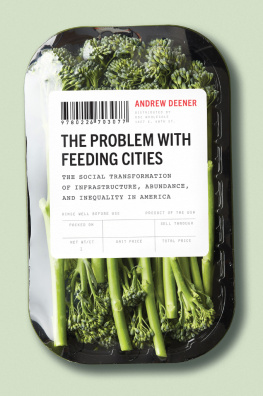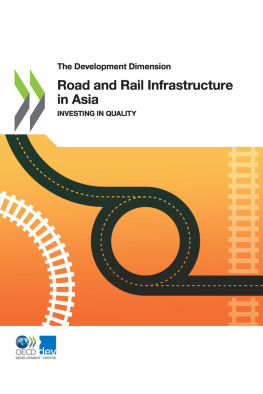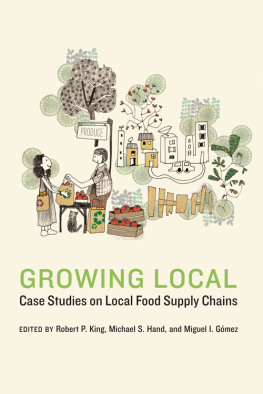
Culinary Infrastructure
Over the past two centuries, global commodity chains and industrial food processing systems have been built on an infrastructure of critical but often-overlooked facilities and technologies used to transport food and to convey knowledge about food. This culinary infrastructure comprises both material components (such as grain elevators, transportation networks, and marketplaces) and immaterial or embodied expressions of knowledge (cooking schools, restaurant guides, quality certifications, and health regulations). Although infrastructural failures can result in supply shortages and food contamination, the indirect consequences of infrastructure can be just as important in shaping the kinds of foods that are available to consumers and who will profit from the sale of those foods.
This volume examines the historical development of a variety of infrastructural nodes and linkages, including refrigerated packing plants in Nazi-occupied Europe, trans-Atlantic restaurant labour markets, food safety technologies and discourses in Singapore, culinary programming in Canadian museums, and dietary studies in colonial Africa. By paying attention to control over facilities and technologies as well as the publicprivate balance over investment and regulation, the authors reveal global inequalities that arise from differential access to culinary infrastructure.
This book was originally published as a special issue of Global Food History.
Jeffrey M. Pilcher is Professor of Food History at the University of Toronto, Canada, and the author of several books, including Que vivan los tamales! Food and the Making of Mexican Identity (1998), Planet Taco: A Global History of Mexican Food (2012), and Food in World History (2d ed., 2017).
Culinary Infrastructure
Edited by
Jeffrey M. Pilcher
First published 2018
by Routledge
2 Park Square, Milton Park, Abingdon, Oxon, OX14 4RN, UK
and by Routledge
711 Third Avenue, New York, NY 10017, USA
Routledge is an imprint of the Taylor & Francis Group, an informa business
2018 Taylor & Francis
All rights reserved. No part of this book may be reprinted or reproduced or utilised in any form or by any electronic, mechanical, or other means, now known or hereafter invented, including photocopying and recording, or in any information storage or retrieval system, without permission in writing from the publishers.
Trademark notice: Product or corporate names may be trademarks or registered trademarks, and are used only for identification and explanation without intent to infringe.
British Library Cataloguing in Publication Data
A catalogue record for this book is available from the British Library
ISBN 13: 978-1-138-56426-8
Typeset in Minion Pro
by RefineCatch Limited, Bungay, Suffolk
Publishers Note
The publisher accepts responsibility for any inconsistencies that may have arisen during the conversion of this book from journal articles to book chapters, namely the possible inclusion of journal terminology.
Disclaimer
Every effort has been made to contact copyright holders for their permission to reprint material in this book. The publishers would be grateful to hear from any copyright holder who is not here acknowledged and will undertake to rectify any errors or omissions in future editions of this book.
Contents
Citation Information
The chapters in this book were originally published in Global Food History, volume 2, issue 2 (September 2016). When citing this material, please use the original page numbering for each article, as follows:
Chapter 1
Culinary Infrastructure: How Facilities and Technologies Create Value and Meaning around Food
Jeffrey M. Pilcher
Global Food History, volume 2, issue 2 (September 2016), pp. 105131
Chapter 3
Food Safety as Culinary Infrastructure in Singapore, 19201990
Nicole Tarulevicz
Global Food History, volume 2, issue 2 (September 2016), pp. 132156
Chapter 4
A Museums Culinary Life: Womens Committees and Food at the Art Gallery of Toronto
Irina D. Mihalache
Global Food History, volume 2, issue 2 (September 2016), pp. 157178
Chapter 5
Developing Constipation: Dietary Fiber, Western Disease, and Industrial Carbohydrates
Sebastin Gil-Riao and Sarah E. Tracy
Global Food History, volume 2, issue 2 (September 2016), pp. 179209
The following chapter was originally published in Global Food History, volume 2, issue 1 (2016). When citing this material, please use the original page numbering for the article, as follows:
Chapter 2
Frozen Food and National Socialist Expansionism
Julia S. Torrie
Global Food History, volume 2, issue 1 (2016), pp. 5173
For any permission-related enquiries please visit:
http://www.tandfonline.com/page/help/permissions
Notes on Contributors
Sebastin Gil-Riao is Assistant Professor in Department of History and Sociology of Science at the University of Pennsylvania, USA. His research focuses on the twentieth-century history of scientific racial conceptions in the Global South.
Irina D. Mihalache is Assistant Professor of Museum Studies at the Faculty of Information, University of Toronto, Canada. Her academic background in communication and cultural studies, paired with her interest in food studies, has developed into a research agenda which inquires about the intersections between food and museums.
Jeffrey M. Pilcher is Professor of Food History at the University of Toronto, Canada, and the author of several books, including Que vivan los tamales! Food and the Making of Mexican Identity (1998), Planet Taco: A Global History of Mexican Food (2012), and Food in World History (2d ed., 2017).
Nicole Tarulevicz is a tenured Senior Lecturer in the School of Humanities at the University of Tasmania, Australia. She is the author of Eating Her Curries and Kway: A Cultural History of Food in Singapore (2013) and a recipient of the Association for the Study of Food and Society (ASFS) Award for Pedagogy (2013). She was elected to the Board of ASFS in 2014.
Julia S. Torrie, PhD, is a Professor of History at St. Thomas University in Fredericton, Canada. Her research explores the social and cultural history of Germany and its neighbours, especially France, in the mid-twentieth century. In addition to journal articles and book chapters on tourism, photography, civilian aid, and popular protest, she has written a comparative, transnational study of civilian evacuations, For Their Own Good: German and French Civilian Evacuations, 193944 (2010).
Sarah E. Tracy is Assistant Adjunct Professor at UCLAs Centre for the Study of Women and Institute for Society and Genetics, USA. Her work draws on feminist science and technology studies (STS), food studies, sensory studies, and postcolonial studies.
Introduction: Culinary Infrastructure
Jeffrey M. Pilcher








